Acute Severe Asthma: Comprehensive Concept Map and Guided Response
VerifiedAdded on 2023/06/03
|9
|2330
|365
Homework Assignment
AI Summary
This assignment is a comprehensive analysis of acute severe asthma, addressing the pathophysiology of the condition, including airway inflammation, hyper-responsiveness, and mucus hypersecretion. The student's response details the clinical manifestations of a patient, Jason Smith, including dyspnea, wheezing, and altered vital signs. The assignment then outlines two key nursing strategies: airway clearance through cough enhancement and increasing oxygen saturation levels. Furthermore, it explores the use of nebulized medications like Salbutamol, Ipratropium, and Hydrocortisone, detailing their mechanisms of action and the importance of careful patient surveillance during and after administration. The solution integrates relevant research to support the proposed interventions and provides a thorough understanding of managing acute severe asthma.
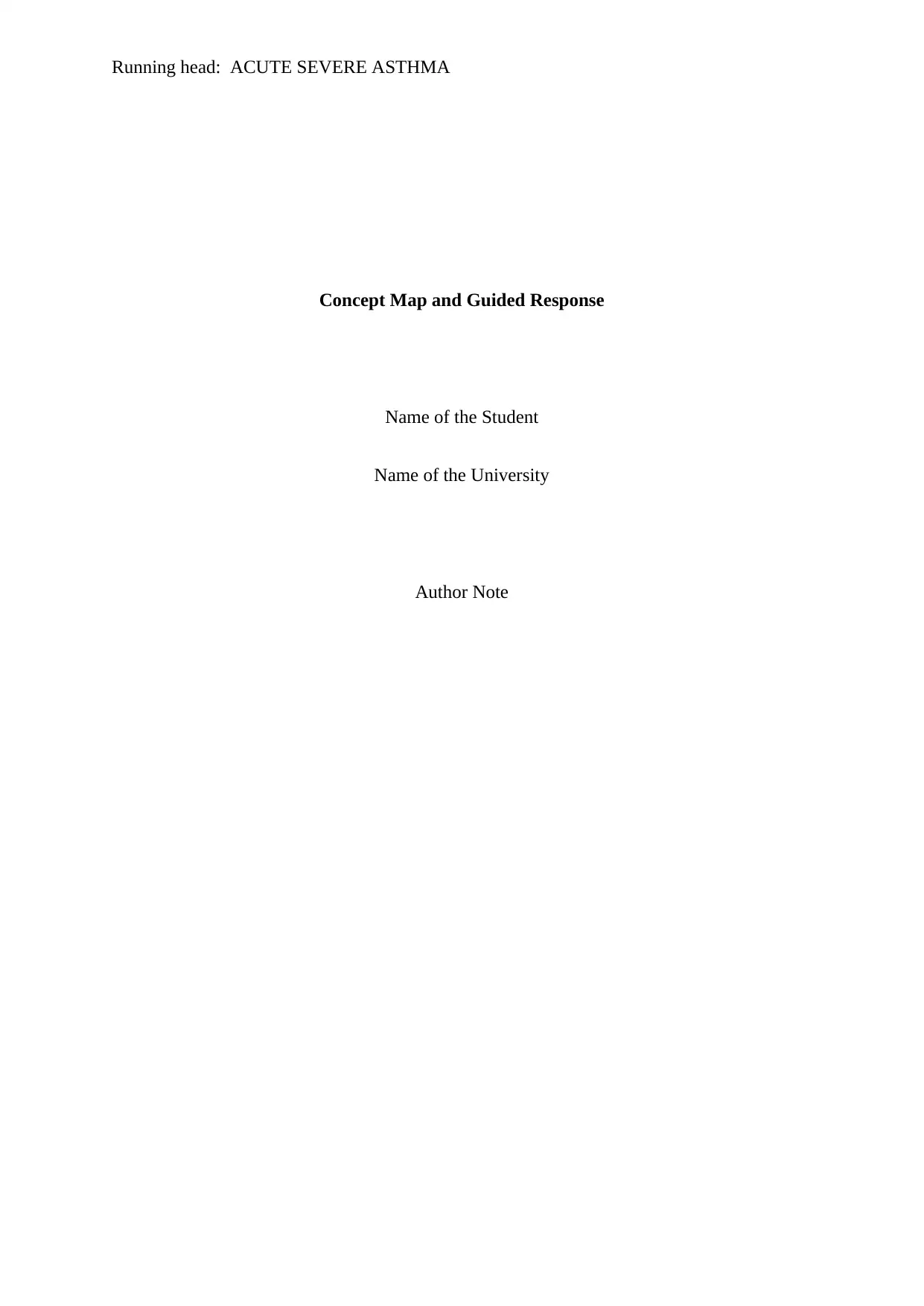
Running head: ACUTE SEVERE ASTHMA
Concept Map and Guided Response
Name of the Student
Name of the University
Author Note
Concept Map and Guided Response
Name of the Student
Name of the University
Author Note
Paraphrase This Document
Need a fresh take? Get an instant paraphrase of this document with our AI Paraphraser
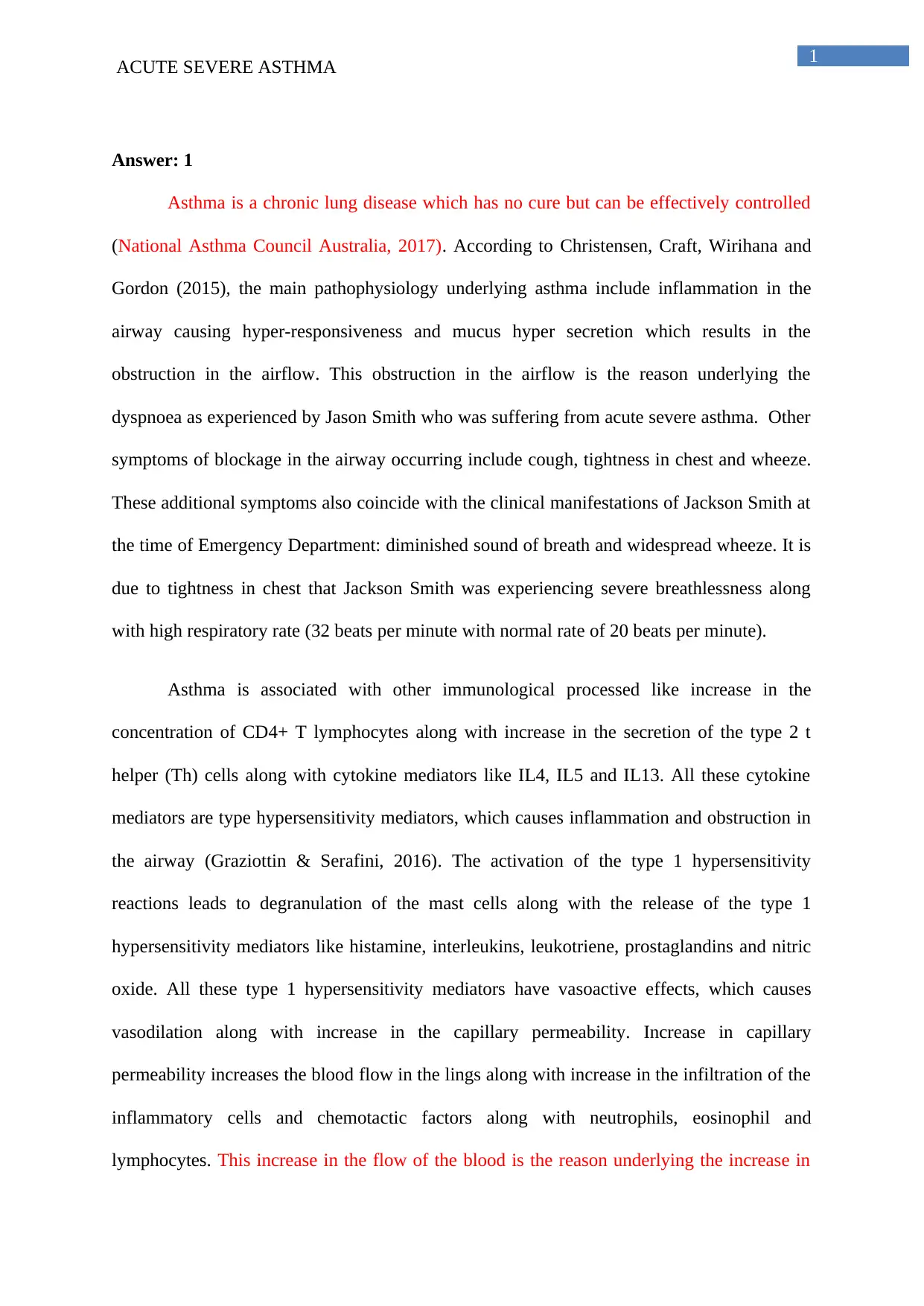
1
ACUTE SEVERE ASTHMA
Answer: 1
Asthma is a chronic lung disease which has no cure but can be effectively controlled
(National Asthma Council Australia, 2017). According to Christensen, Craft, Wirihana and
Gordon (2015), the main pathophysiology underlying asthma include inflammation in the
airway causing hyper-responsiveness and mucus hyper secretion which results in the
obstruction in the airflow. This obstruction in the airflow is the reason underlying the
dyspnoea as experienced by Jason Smith who was suffering from acute severe asthma. Other
symptoms of blockage in the airway occurring include cough, tightness in chest and wheeze.
These additional symptoms also coincide with the clinical manifestations of Jackson Smith at
the time of Emergency Department: diminished sound of breath and widespread wheeze. It is
due to tightness in chest that Jackson Smith was experiencing severe breathlessness along
with high respiratory rate (32 beats per minute with normal rate of 20 beats per minute).
Asthma is associated with other immunological processed like increase in the
concentration of CD4+ T lymphocytes along with increase in the secretion of the type 2 t
helper (Th) cells along with cytokine mediators like IL4, IL5 and IL13. All these cytokine
mediators are type hypersensitivity mediators, which causes inflammation and obstruction in
the airway (Graziottin & Serafini, 2016). The activation of the type 1 hypersensitivity
reactions leads to degranulation of the mast cells along with the release of the type 1
hypersensitivity mediators like histamine, interleukins, leukotriene, prostaglandins and nitric
oxide. All these type 1 hypersensitivity mediators have vasoactive effects, which causes
vasodilation along with increase in the capillary permeability. Increase in capillary
permeability increases the blood flow in the lings along with increase in the infiltration of the
inflammatory cells and chemotactic factors along with neutrophils, eosinophil and
lymphocytes. This increase in the flow of the blood is the reason underlying the increase in
ACUTE SEVERE ASTHMA
Answer: 1
Asthma is a chronic lung disease which has no cure but can be effectively controlled
(National Asthma Council Australia, 2017). According to Christensen, Craft, Wirihana and
Gordon (2015), the main pathophysiology underlying asthma include inflammation in the
airway causing hyper-responsiveness and mucus hyper secretion which results in the
obstruction in the airflow. This obstruction in the airflow is the reason underlying the
dyspnoea as experienced by Jason Smith who was suffering from acute severe asthma. Other
symptoms of blockage in the airway occurring include cough, tightness in chest and wheeze.
These additional symptoms also coincide with the clinical manifestations of Jackson Smith at
the time of Emergency Department: diminished sound of breath and widespread wheeze. It is
due to tightness in chest that Jackson Smith was experiencing severe breathlessness along
with high respiratory rate (32 beats per minute with normal rate of 20 beats per minute).
Asthma is associated with other immunological processed like increase in the
concentration of CD4+ T lymphocytes along with increase in the secretion of the type 2 t
helper (Th) cells along with cytokine mediators like IL4, IL5 and IL13. All these cytokine
mediators are type hypersensitivity mediators, which causes inflammation and obstruction in
the airway (Graziottin & Serafini, 2016). The activation of the type 1 hypersensitivity
reactions leads to degranulation of the mast cells along with the release of the type 1
hypersensitivity mediators like histamine, interleukins, leukotriene, prostaglandins and nitric
oxide. All these type 1 hypersensitivity mediators have vasoactive effects, which causes
vasodilation along with increase in the capillary permeability. Increase in capillary
permeability increases the blood flow in the lings along with increase in the infiltration of the
inflammatory cells and chemotactic factors along with neutrophils, eosinophil and
lymphocytes. This increase in the flow of the blood is the reason underlying the increase in
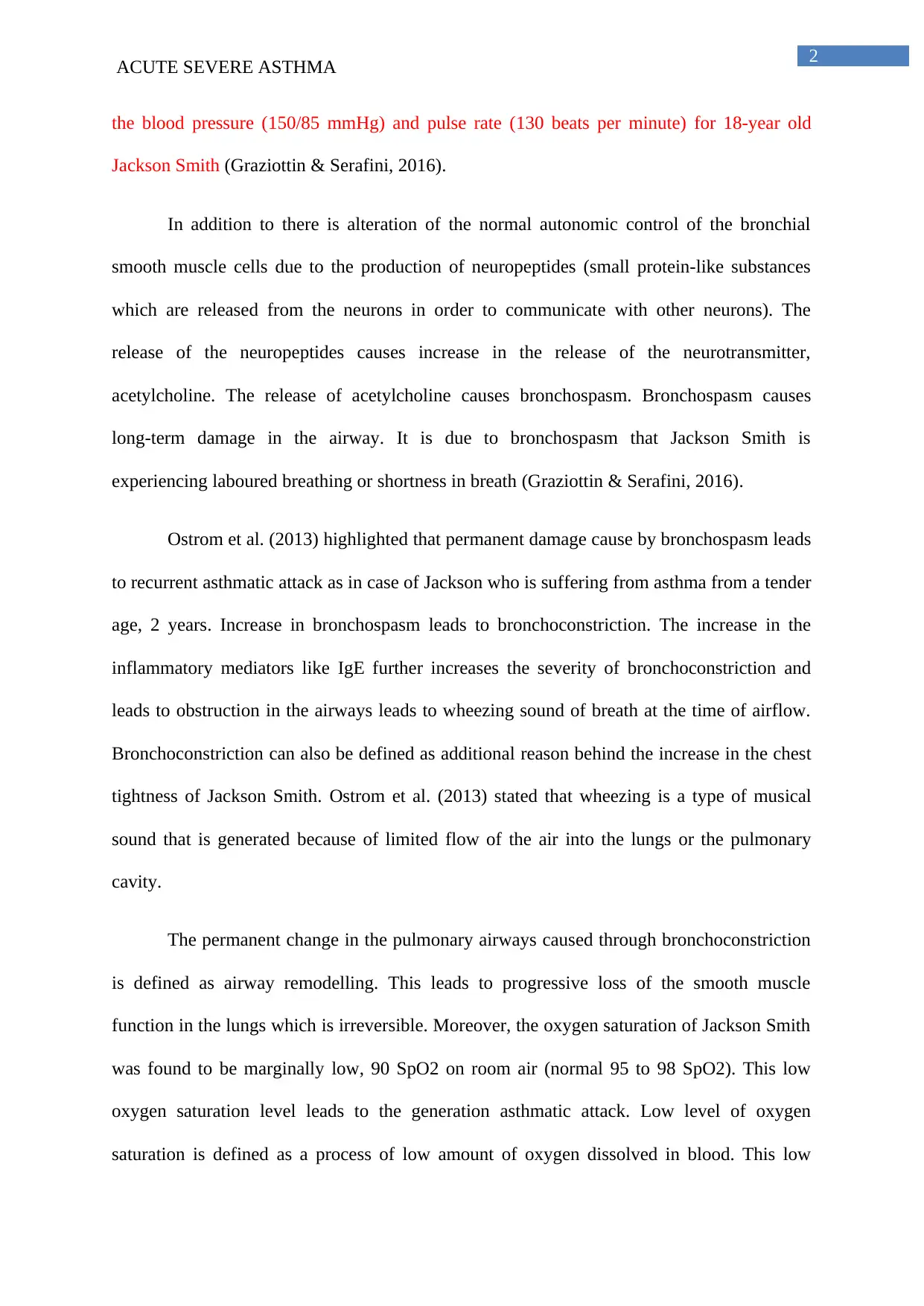
2
ACUTE SEVERE ASTHMA
the blood pressure (150/85 mmHg) and pulse rate (130 beats per minute) for 18-year old
Jackson Smith (Graziottin & Serafini, 2016).
In addition to there is alteration of the normal autonomic control of the bronchial
smooth muscle cells due to the production of neuropeptides (small protein-like substances
which are released from the neurons in order to communicate with other neurons). The
release of the neuropeptides causes increase in the release of the neurotransmitter,
acetylcholine. The release of acetylcholine causes bronchospasm. Bronchospasm causes
long-term damage in the airway. It is due to bronchospasm that Jackson Smith is
experiencing laboured breathing or shortness in breath (Graziottin & Serafini, 2016).
Ostrom et al. (2013) highlighted that permanent damage cause by bronchospasm leads
to recurrent asthmatic attack as in case of Jackson who is suffering from asthma from a tender
age, 2 years. Increase in bronchospasm leads to bronchoconstriction. The increase in the
inflammatory mediators like IgE further increases the severity of bronchoconstriction and
leads to obstruction in the airways leads to wheezing sound of breath at the time of airflow.
Bronchoconstriction can also be defined as additional reason behind the increase in the chest
tightness of Jackson Smith. Ostrom et al. (2013) stated that wheezing is a type of musical
sound that is generated because of limited flow of the air into the lungs or the pulmonary
cavity.
The permanent change in the pulmonary airways caused through bronchoconstriction
is defined as airway remodelling. This leads to progressive loss of the smooth muscle
function in the lungs which is irreversible. Moreover, the oxygen saturation of Jackson Smith
was found to be marginally low, 90 SpO2 on room air (normal 95 to 98 SpO2). This low
oxygen saturation level leads to the generation asthmatic attack. Low level of oxygen
saturation is defined as a process of low amount of oxygen dissolved in blood. This low
ACUTE SEVERE ASTHMA
the blood pressure (150/85 mmHg) and pulse rate (130 beats per minute) for 18-year old
Jackson Smith (Graziottin & Serafini, 2016).
In addition to there is alteration of the normal autonomic control of the bronchial
smooth muscle cells due to the production of neuropeptides (small protein-like substances
which are released from the neurons in order to communicate with other neurons). The
release of the neuropeptides causes increase in the release of the neurotransmitter,
acetylcholine. The release of acetylcholine causes bronchospasm. Bronchospasm causes
long-term damage in the airway. It is due to bronchospasm that Jackson Smith is
experiencing laboured breathing or shortness in breath (Graziottin & Serafini, 2016).
Ostrom et al. (2013) highlighted that permanent damage cause by bronchospasm leads
to recurrent asthmatic attack as in case of Jackson who is suffering from asthma from a tender
age, 2 years. Increase in bronchospasm leads to bronchoconstriction. The increase in the
inflammatory mediators like IgE further increases the severity of bronchoconstriction and
leads to obstruction in the airways leads to wheezing sound of breath at the time of airflow.
Bronchoconstriction can also be defined as additional reason behind the increase in the chest
tightness of Jackson Smith. Ostrom et al. (2013) stated that wheezing is a type of musical
sound that is generated because of limited flow of the air into the lungs or the pulmonary
cavity.
The permanent change in the pulmonary airways caused through bronchoconstriction
is defined as airway remodelling. This leads to progressive loss of the smooth muscle
function in the lungs which is irreversible. Moreover, the oxygen saturation of Jackson Smith
was found to be marginally low, 90 SpO2 on room air (normal 95 to 98 SpO2). This low
oxygen saturation level leads to the generation asthmatic attack. Low level of oxygen
saturation is defined as a process of low amount of oxygen dissolved in blood. This low
⊘ This is a preview!⊘
Do you want full access?
Subscribe today to unlock all pages.

Trusted by 1+ million students worldwide
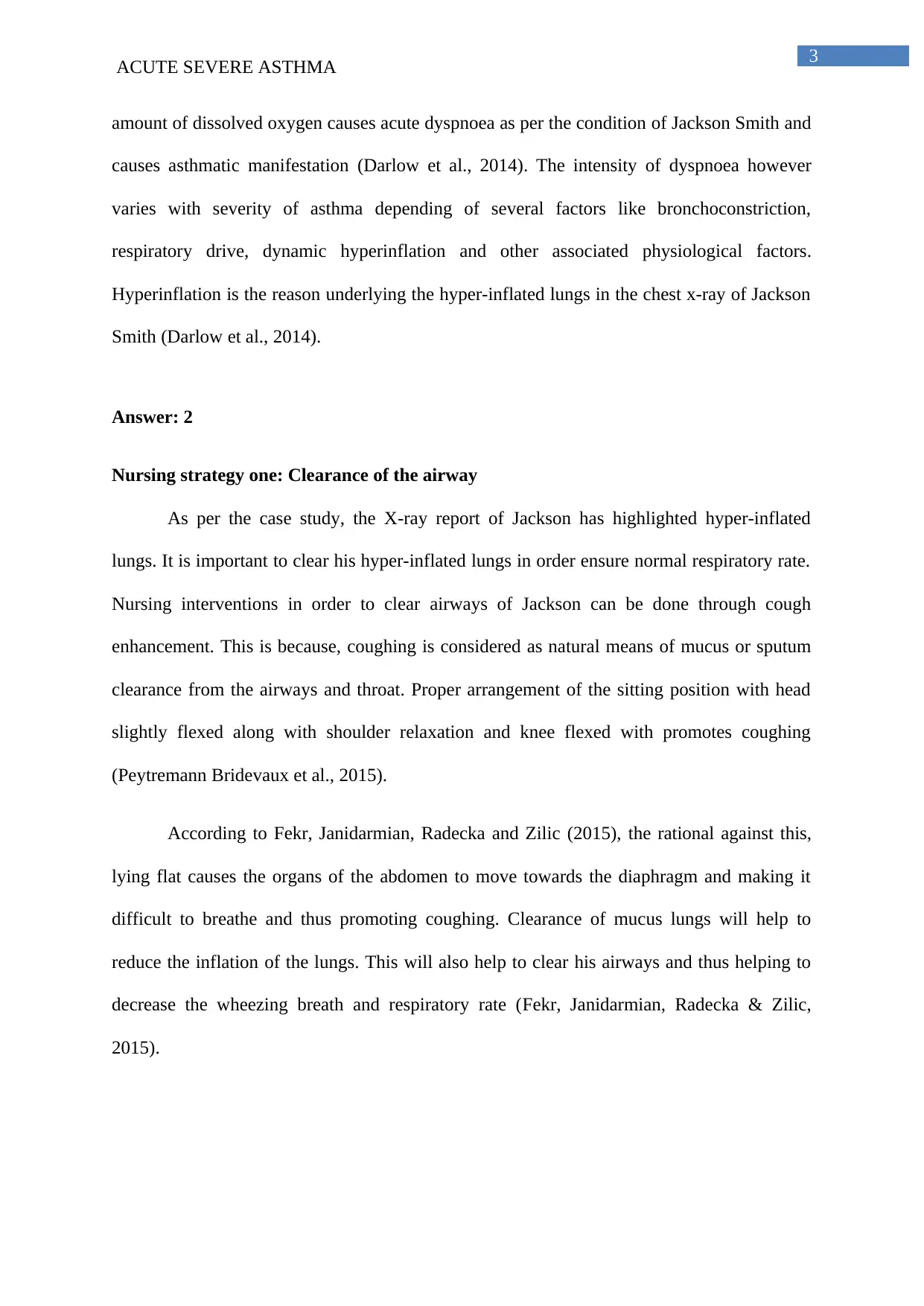
3
ACUTE SEVERE ASTHMA
amount of dissolved oxygen causes acute dyspnoea as per the condition of Jackson Smith and
causes asthmatic manifestation (Darlow et al., 2014). The intensity of dyspnoea however
varies with severity of asthma depending of several factors like bronchoconstriction,
respiratory drive, dynamic hyperinflation and other associated physiological factors.
Hyperinflation is the reason underlying the hyper-inflated lungs in the chest x-ray of Jackson
Smith (Darlow et al., 2014).
Answer: 2
Nursing strategy one: Clearance of the airway
As per the case study, the X-ray report of Jackson has highlighted hyper-inflated
lungs. It is important to clear his hyper-inflated lungs in order ensure normal respiratory rate.
Nursing interventions in order to clear airways of Jackson can be done through cough
enhancement. This is because, coughing is considered as natural means of mucus or sputum
clearance from the airways and throat. Proper arrangement of the sitting position with head
slightly flexed along with shoulder relaxation and knee flexed with promotes coughing
(Peytremann Bridevaux et al., 2015).
According to Fekr, Janidarmian, Radecka and Zilic (2015), the rational against this,
lying flat causes the organs of the abdomen to move towards the diaphragm and making it
difficult to breathe and thus promoting coughing. Clearance of mucus lungs will help to
reduce the inflation of the lungs. This will also help to clear his airways and thus helping to
decrease the wheezing breath and respiratory rate (Fekr, Janidarmian, Radecka & Zilic,
2015).
ACUTE SEVERE ASTHMA
amount of dissolved oxygen causes acute dyspnoea as per the condition of Jackson Smith and
causes asthmatic manifestation (Darlow et al., 2014). The intensity of dyspnoea however
varies with severity of asthma depending of several factors like bronchoconstriction,
respiratory drive, dynamic hyperinflation and other associated physiological factors.
Hyperinflation is the reason underlying the hyper-inflated lungs in the chest x-ray of Jackson
Smith (Darlow et al., 2014).
Answer: 2
Nursing strategy one: Clearance of the airway
As per the case study, the X-ray report of Jackson has highlighted hyper-inflated
lungs. It is important to clear his hyper-inflated lungs in order ensure normal respiratory rate.
Nursing interventions in order to clear airways of Jackson can be done through cough
enhancement. This is because, coughing is considered as natural means of mucus or sputum
clearance from the airways and throat. Proper arrangement of the sitting position with head
slightly flexed along with shoulder relaxation and knee flexed with promotes coughing
(Peytremann Bridevaux et al., 2015).
According to Fekr, Janidarmian, Radecka and Zilic (2015), the rational against this,
lying flat causes the organs of the abdomen to move towards the diaphragm and making it
difficult to breathe and thus promoting coughing. Clearance of mucus lungs will help to
reduce the inflation of the lungs. This will also help to clear his airways and thus helping to
decrease the wheezing breath and respiratory rate (Fekr, Janidarmian, Radecka & Zilic,
2015).
Paraphrase This Document
Need a fresh take? Get an instant paraphrase of this document with our AI Paraphraser
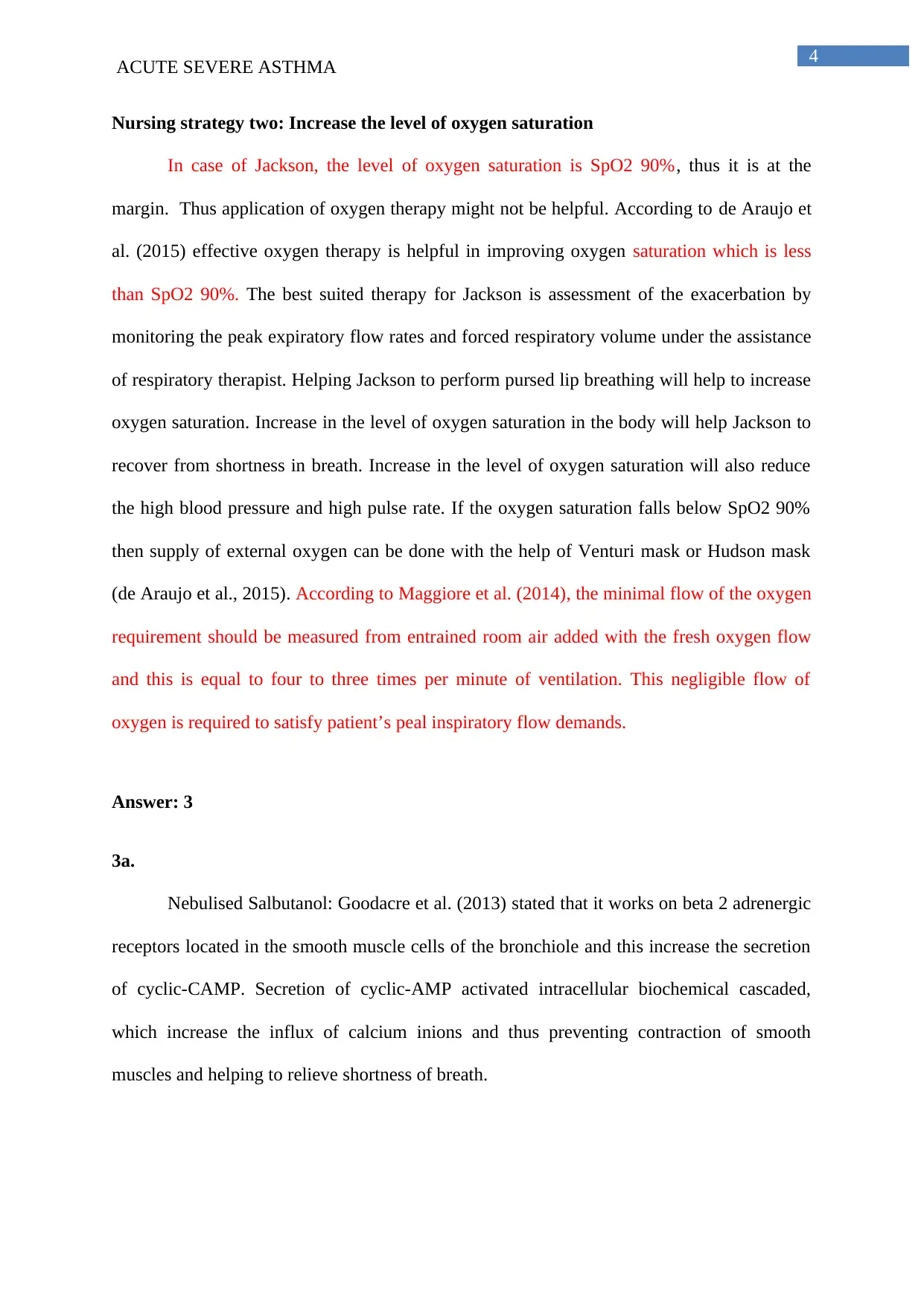
4
ACUTE SEVERE ASTHMA
Nursing strategy two: Increase the level of oxygen saturation
In case of Jackson, the level of oxygen saturation is SpO2 90%, thus it is at the
margin. Thus application of oxygen therapy might not be helpful. According to de Araujo et
al. (2015) effective oxygen therapy is helpful in improving oxygen saturation which is less
than SpO2 90%. The best suited therapy for Jackson is assessment of the exacerbation by
monitoring the peak expiratory flow rates and forced respiratory volume under the assistance
of respiratory therapist. Helping Jackson to perform pursed lip breathing will help to increase
oxygen saturation. Increase in the level of oxygen saturation in the body will help Jackson to
recover from shortness in breath. Increase in the level of oxygen saturation will also reduce
the high blood pressure and high pulse rate. If the oxygen saturation falls below SpO2 90%
then supply of external oxygen can be done with the help of Venturi mask or Hudson mask
(de Araujo et al., 2015). According to Maggiore et al. (2014), the minimal flow of the oxygen
requirement should be measured from entrained room air added with the fresh oxygen flow
and this is equal to four to three times per minute of ventilation. This negligible flow of
oxygen is required to satisfy patient’s peal inspiratory flow demands.
Answer: 3
3a.
Nebulised Salbutanol: Goodacre et al. (2013) stated that it works on beta 2 adrenergic
receptors located in the smooth muscle cells of the bronchiole and this increase the secretion
of cyclic-CAMP. Secretion of cyclic-AMP activated intracellular biochemical cascaded,
which increase the influx of calcium inions and thus preventing contraction of smooth
muscles and helping to relieve shortness of breath.
ACUTE SEVERE ASTHMA
Nursing strategy two: Increase the level of oxygen saturation
In case of Jackson, the level of oxygen saturation is SpO2 90%, thus it is at the
margin. Thus application of oxygen therapy might not be helpful. According to de Araujo et
al. (2015) effective oxygen therapy is helpful in improving oxygen saturation which is less
than SpO2 90%. The best suited therapy for Jackson is assessment of the exacerbation by
monitoring the peak expiratory flow rates and forced respiratory volume under the assistance
of respiratory therapist. Helping Jackson to perform pursed lip breathing will help to increase
oxygen saturation. Increase in the level of oxygen saturation in the body will help Jackson to
recover from shortness in breath. Increase in the level of oxygen saturation will also reduce
the high blood pressure and high pulse rate. If the oxygen saturation falls below SpO2 90%
then supply of external oxygen can be done with the help of Venturi mask or Hudson mask
(de Araujo et al., 2015). According to Maggiore et al. (2014), the minimal flow of the oxygen
requirement should be measured from entrained room air added with the fresh oxygen flow
and this is equal to four to three times per minute of ventilation. This negligible flow of
oxygen is required to satisfy patient’s peal inspiratory flow demands.
Answer: 3
3a.
Nebulised Salbutanol: Goodacre et al. (2013) stated that it works on beta 2 adrenergic
receptors located in the smooth muscle cells of the bronchiole and this increase the secretion
of cyclic-CAMP. Secretion of cyclic-AMP activated intracellular biochemical cascaded,
which increase the influx of calcium inions and thus preventing contraction of smooth
muscles and helping to relieve shortness of breath.
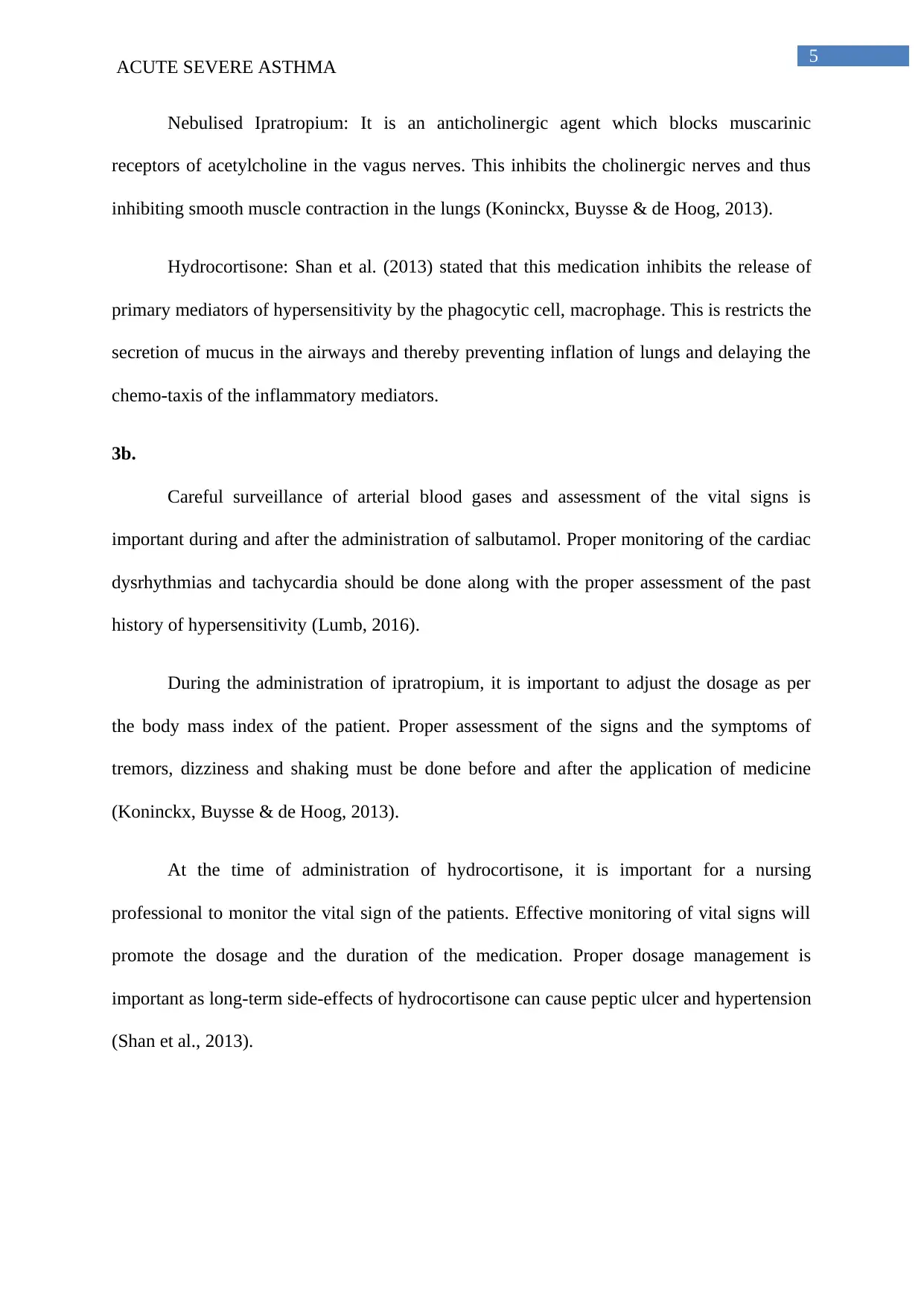
5
ACUTE SEVERE ASTHMA
Nebulised Ipratropium: It is an anticholinergic agent which blocks muscarinic
receptors of acetylcholine in the vagus nerves. This inhibits the cholinergic nerves and thus
inhibiting smooth muscle contraction in the lungs (Koninckx, Buysse & de Hoog, 2013).
Hydrocortisone: Shan et al. (2013) stated that this medication inhibits the release of
primary mediators of hypersensitivity by the phagocytic cell, macrophage. This is restricts the
secretion of mucus in the airways and thereby preventing inflation of lungs and delaying the
chemo-taxis of the inflammatory mediators.
3b.
Careful surveillance of arterial blood gases and assessment of the vital signs is
important during and after the administration of salbutamol. Proper monitoring of the cardiac
dysrhythmias and tachycardia should be done along with the proper assessment of the past
history of hypersensitivity (Lumb, 2016).
During the administration of ipratropium, it is important to adjust the dosage as per
the body mass index of the patient. Proper assessment of the signs and the symptoms of
tremors, dizziness and shaking must be done before and after the application of medicine
(Koninckx, Buysse & de Hoog, 2013).
At the time of administration of hydrocortisone, it is important for a nursing
professional to monitor the vital sign of the patients. Effective monitoring of vital signs will
promote the dosage and the duration of the medication. Proper dosage management is
important as long-term side-effects of hydrocortisone can cause peptic ulcer and hypertension
(Shan et al., 2013).
ACUTE SEVERE ASTHMA
Nebulised Ipratropium: It is an anticholinergic agent which blocks muscarinic
receptors of acetylcholine in the vagus nerves. This inhibits the cholinergic nerves and thus
inhibiting smooth muscle contraction in the lungs (Koninckx, Buysse & de Hoog, 2013).
Hydrocortisone: Shan et al. (2013) stated that this medication inhibits the release of
primary mediators of hypersensitivity by the phagocytic cell, macrophage. This is restricts the
secretion of mucus in the airways and thereby preventing inflation of lungs and delaying the
chemo-taxis of the inflammatory mediators.
3b.
Careful surveillance of arterial blood gases and assessment of the vital signs is
important during and after the administration of salbutamol. Proper monitoring of the cardiac
dysrhythmias and tachycardia should be done along with the proper assessment of the past
history of hypersensitivity (Lumb, 2016).
During the administration of ipratropium, it is important to adjust the dosage as per
the body mass index of the patient. Proper assessment of the signs and the symptoms of
tremors, dizziness and shaking must be done before and after the application of medicine
(Koninckx, Buysse & de Hoog, 2013).
At the time of administration of hydrocortisone, it is important for a nursing
professional to monitor the vital sign of the patients. Effective monitoring of vital signs will
promote the dosage and the duration of the medication. Proper dosage management is
important as long-term side-effects of hydrocortisone can cause peptic ulcer and hypertension
(Shan et al., 2013).
⊘ This is a preview!⊘
Do you want full access?
Subscribe today to unlock all pages.

Trusted by 1+ million students worldwide
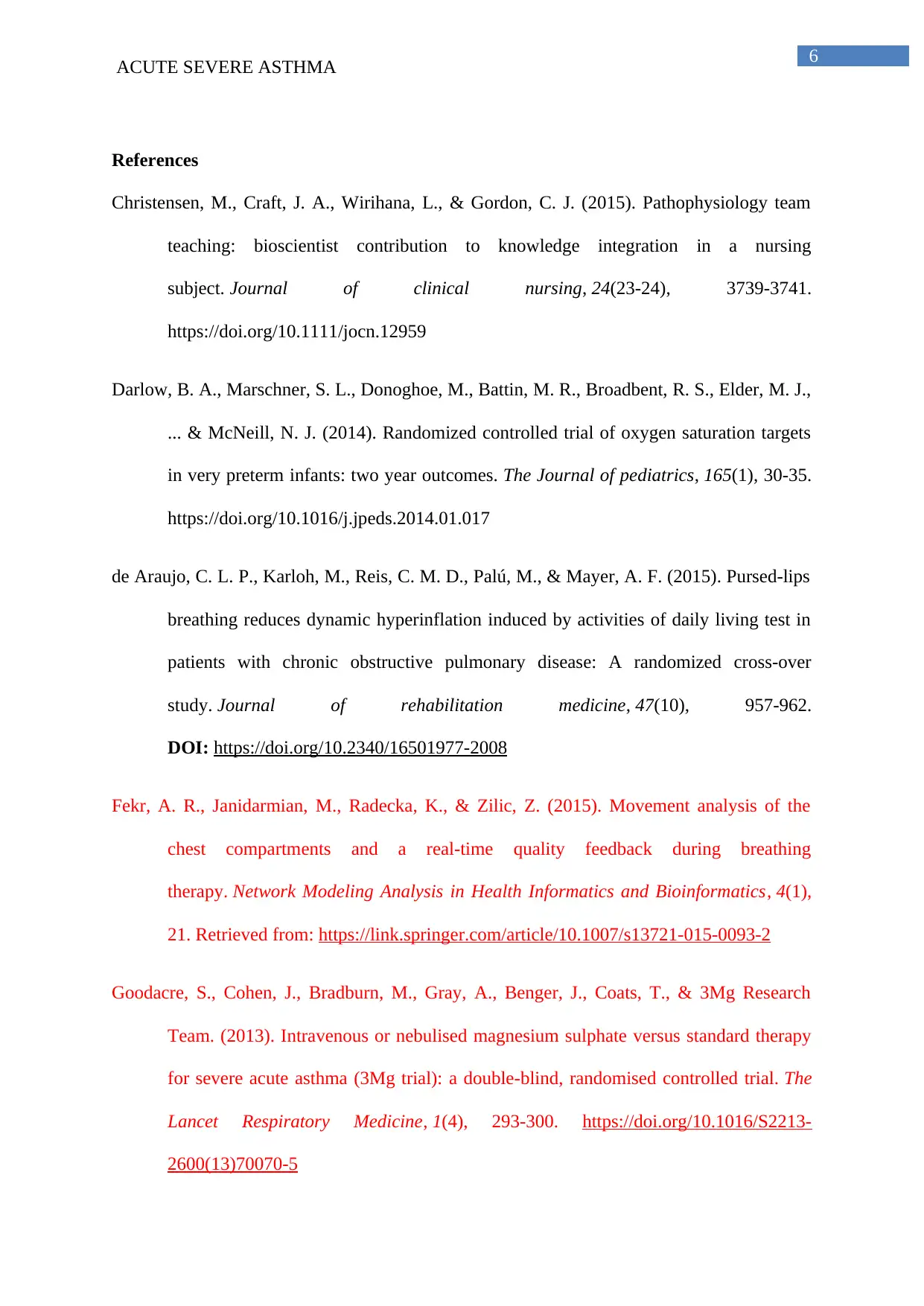
6
ACUTE SEVERE ASTHMA
References
Christensen, M., Craft, J. A., Wirihana, L., & Gordon, C. J. (2015). Pathophysiology team
teaching: bioscientist contribution to knowledge integration in a nursing
subject. Journal of clinical nursing, 24(23-24), 3739-3741.
https://doi.org/10.1111/jocn.12959
Darlow, B. A., Marschner, S. L., Donoghoe, M., Battin, M. R., Broadbent, R. S., Elder, M. J.,
... & McNeill, N. J. (2014). Randomized controlled trial of oxygen saturation targets
in very preterm infants: two year outcomes. The Journal of pediatrics, 165(1), 30-35.
https://doi.org/10.1016/j.jpeds.2014.01.017
de Araujo, C. L. P., Karloh, M., Reis, C. M. D., Palú, M., & Mayer, A. F. (2015). Pursed-lips
breathing reduces dynamic hyperinflation induced by activities of daily living test in
patients with chronic obstructive pulmonary disease: A randomized cross-over
study. Journal of rehabilitation medicine, 47(10), 957-962.
DOI: https://doi.org/10.2340/16501977-2008
Fekr, A. R., Janidarmian, M., Radecka, K., & Zilic, Z. (2015). Movement analysis of the
chest compartments and a real-time quality feedback during breathing
therapy. Network Modeling Analysis in Health Informatics and Bioinformatics, 4(1),
21. Retrieved from: https://link.springer.com/article/10.1007/s13721-015-0093-2
Goodacre, S., Cohen, J., Bradburn, M., Gray, A., Benger, J., Coats, T., & 3Mg Research
Team. (2013). Intravenous or nebulised magnesium sulphate versus standard therapy
for severe acute asthma (3Mg trial): a double-blind, randomised controlled trial. The
Lancet Respiratory Medicine, 1(4), 293-300. https://doi.org/10.1016/S2213-
2600(13)70070-5
ACUTE SEVERE ASTHMA
References
Christensen, M., Craft, J. A., Wirihana, L., & Gordon, C. J. (2015). Pathophysiology team
teaching: bioscientist contribution to knowledge integration in a nursing
subject. Journal of clinical nursing, 24(23-24), 3739-3741.
https://doi.org/10.1111/jocn.12959
Darlow, B. A., Marschner, S. L., Donoghoe, M., Battin, M. R., Broadbent, R. S., Elder, M. J.,
... & McNeill, N. J. (2014). Randomized controlled trial of oxygen saturation targets
in very preterm infants: two year outcomes. The Journal of pediatrics, 165(1), 30-35.
https://doi.org/10.1016/j.jpeds.2014.01.017
de Araujo, C. L. P., Karloh, M., Reis, C. M. D., Palú, M., & Mayer, A. F. (2015). Pursed-lips
breathing reduces dynamic hyperinflation induced by activities of daily living test in
patients with chronic obstructive pulmonary disease: A randomized cross-over
study. Journal of rehabilitation medicine, 47(10), 957-962.
DOI: https://doi.org/10.2340/16501977-2008
Fekr, A. R., Janidarmian, M., Radecka, K., & Zilic, Z. (2015). Movement analysis of the
chest compartments and a real-time quality feedback during breathing
therapy. Network Modeling Analysis in Health Informatics and Bioinformatics, 4(1),
21. Retrieved from: https://link.springer.com/article/10.1007/s13721-015-0093-2
Goodacre, S., Cohen, J., Bradburn, M., Gray, A., Benger, J., Coats, T., & 3Mg Research
Team. (2013). Intravenous or nebulised magnesium sulphate versus standard therapy
for severe acute asthma (3Mg trial): a double-blind, randomised controlled trial. The
Lancet Respiratory Medicine, 1(4), 293-300. https://doi.org/10.1016/S2213-
2600(13)70070-5
Paraphrase This Document
Need a fresh take? Get an instant paraphrase of this document with our AI Paraphraser
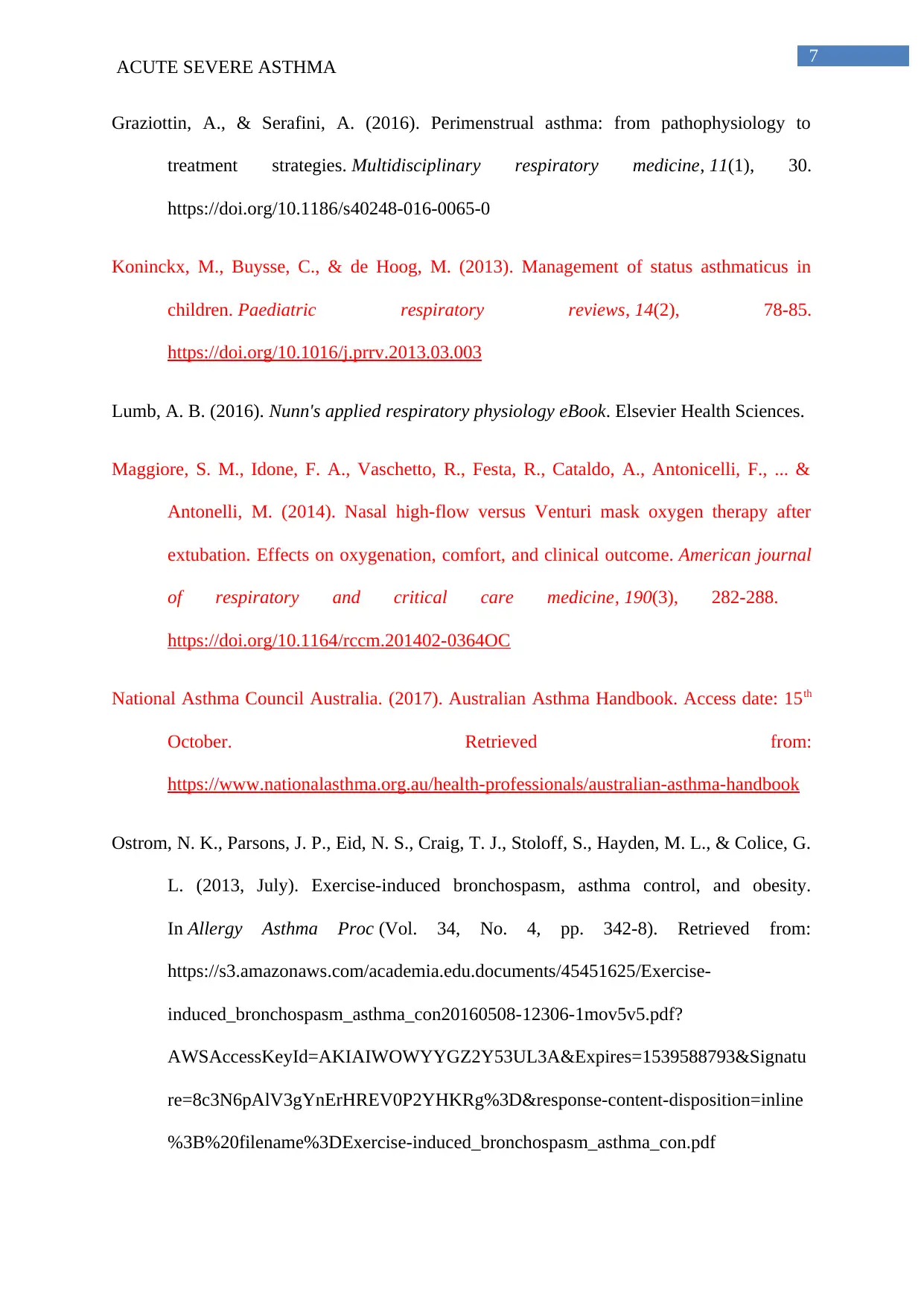
7
ACUTE SEVERE ASTHMA
Graziottin, A., & Serafini, A. (2016). Perimenstrual asthma: from pathophysiology to
treatment strategies. Multidisciplinary respiratory medicine, 11(1), 30.
https://doi.org/10.1186/s40248-016-0065-0
Koninckx, M., Buysse, C., & de Hoog, M. (2013). Management of status asthmaticus in
children. Paediatric respiratory reviews, 14(2), 78-85.
https://doi.org/10.1016/j.prrv.2013.03.003
Lumb, A. B. (2016). Nunn's applied respiratory physiology eBook. Elsevier Health Sciences.
Maggiore, S. M., Idone, F. A., Vaschetto, R., Festa, R., Cataldo, A., Antonicelli, F., ... &
Antonelli, M. (2014). Nasal high-flow versus Venturi mask oxygen therapy after
extubation. Effects on oxygenation, comfort, and clinical outcome. American journal
of respiratory and critical care medicine, 190(3), 282-288.
https://doi.org/10.1164/rccm.201402-0364OC
National Asthma Council Australia. (2017). Australian Asthma Handbook. Access date: 15th
October. Retrieved from:
https://www.nationalasthma.org.au/health-professionals/australian-asthma-handbook
Ostrom, N. K., Parsons, J. P., Eid, N. S., Craig, T. J., Stoloff, S., Hayden, M. L., & Colice, G.
L. (2013, July). Exercise-induced bronchospasm, asthma control, and obesity.
In Allergy Asthma Proc (Vol. 34, No. 4, pp. 342-8). Retrieved from:
https://s3.amazonaws.com/academia.edu.documents/45451625/Exercise-
induced_bronchospasm_asthma_con20160508-12306-1mov5v5.pdf?
AWSAccessKeyId=AKIAIWOWYYGZ2Y53UL3A&Expires=1539588793&Signatu
re=8c3N6pAlV3gYnErHREV0P2YHKRg%3D&response-content-disposition=inline
%3B%20filename%3DExercise-induced_bronchospasm_asthma_con.pdf
ACUTE SEVERE ASTHMA
Graziottin, A., & Serafini, A. (2016). Perimenstrual asthma: from pathophysiology to
treatment strategies. Multidisciplinary respiratory medicine, 11(1), 30.
https://doi.org/10.1186/s40248-016-0065-0
Koninckx, M., Buysse, C., & de Hoog, M. (2013). Management of status asthmaticus in
children. Paediatric respiratory reviews, 14(2), 78-85.
https://doi.org/10.1016/j.prrv.2013.03.003
Lumb, A. B. (2016). Nunn's applied respiratory physiology eBook. Elsevier Health Sciences.
Maggiore, S. M., Idone, F. A., Vaschetto, R., Festa, R., Cataldo, A., Antonicelli, F., ... &
Antonelli, M. (2014). Nasal high-flow versus Venturi mask oxygen therapy after
extubation. Effects on oxygenation, comfort, and clinical outcome. American journal
of respiratory and critical care medicine, 190(3), 282-288.
https://doi.org/10.1164/rccm.201402-0364OC
National Asthma Council Australia. (2017). Australian Asthma Handbook. Access date: 15th
October. Retrieved from:
https://www.nationalasthma.org.au/health-professionals/australian-asthma-handbook
Ostrom, N. K., Parsons, J. P., Eid, N. S., Craig, T. J., Stoloff, S., Hayden, M. L., & Colice, G.
L. (2013, July). Exercise-induced bronchospasm, asthma control, and obesity.
In Allergy Asthma Proc (Vol. 34, No. 4, pp. 342-8). Retrieved from:
https://s3.amazonaws.com/academia.edu.documents/45451625/Exercise-
induced_bronchospasm_asthma_con20160508-12306-1mov5v5.pdf?
AWSAccessKeyId=AKIAIWOWYYGZ2Y53UL3A&Expires=1539588793&Signatu
re=8c3N6pAlV3gYnErHREV0P2YHKRg%3D&response-content-disposition=inline
%3B%20filename%3DExercise-induced_bronchospasm_asthma_con.pdf
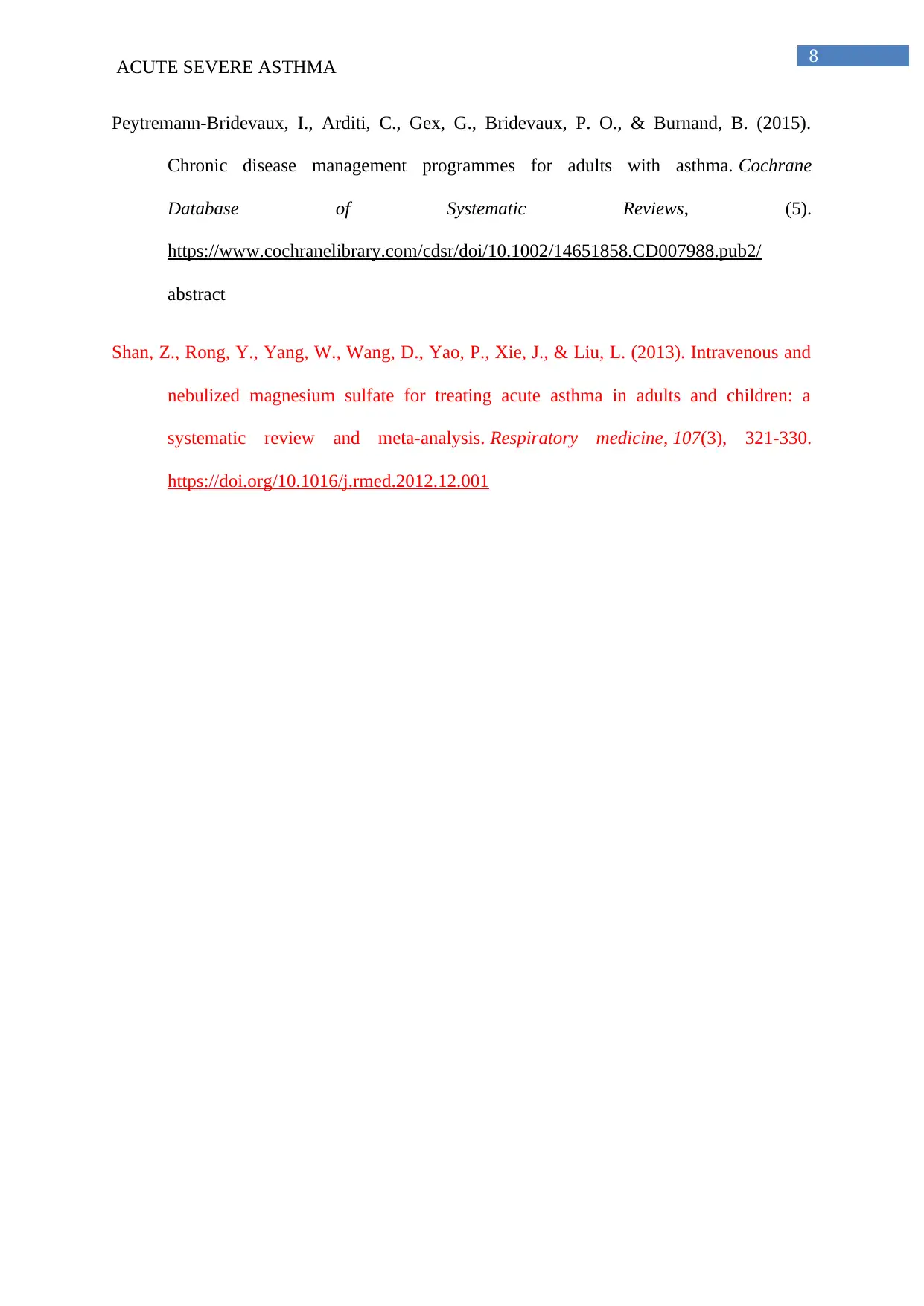
8
ACUTE SEVERE ASTHMA
Peytremann‐Bridevaux, I., Arditi, C., Gex, G., Bridevaux, P. O., & Burnand, B. (2015).
Chronic disease management programmes for adults with asthma. Cochrane
Database of Systematic Reviews, (5).
https://www.cochranelibrary.com/cdsr/doi/10.1002/14651858.CD007988.pub2/
abstract
Shan, Z., Rong, Y., Yang, W., Wang, D., Yao, P., Xie, J., & Liu, L. (2013). Intravenous and
nebulized magnesium sulfate for treating acute asthma in adults and children: a
systematic review and meta-analysis. Respiratory medicine, 107(3), 321-330.
https://doi.org/10.1016/j.rmed.2012.12.001
ACUTE SEVERE ASTHMA
Peytremann‐Bridevaux, I., Arditi, C., Gex, G., Bridevaux, P. O., & Burnand, B. (2015).
Chronic disease management programmes for adults with asthma. Cochrane
Database of Systematic Reviews, (5).
https://www.cochranelibrary.com/cdsr/doi/10.1002/14651858.CD007988.pub2/
abstract
Shan, Z., Rong, Y., Yang, W., Wang, D., Yao, P., Xie, J., & Liu, L. (2013). Intravenous and
nebulized magnesium sulfate for treating acute asthma in adults and children: a
systematic review and meta-analysis. Respiratory medicine, 107(3), 321-330.
https://doi.org/10.1016/j.rmed.2012.12.001
⊘ This is a preview!⊘
Do you want full access?
Subscribe today to unlock all pages.

Trusted by 1+ million students worldwide
1 out of 9
Related Documents
Your All-in-One AI-Powered Toolkit for Academic Success.
+13062052269
info@desklib.com
Available 24*7 on WhatsApp / Email
![[object Object]](/_next/static/media/star-bottom.7253800d.svg)
Unlock your academic potential
Copyright © 2020–2025 A2Z Services. All Rights Reserved. Developed and managed by ZUCOL.

